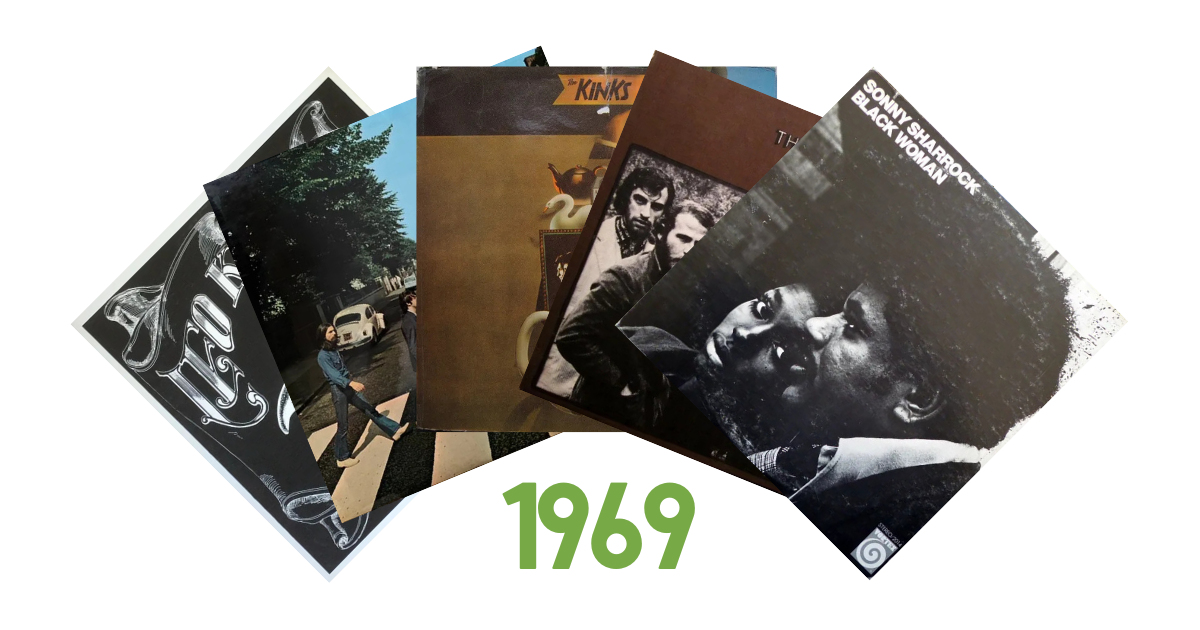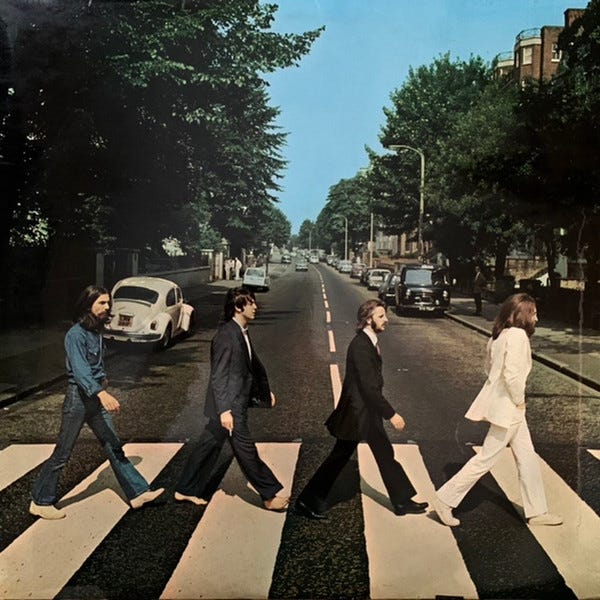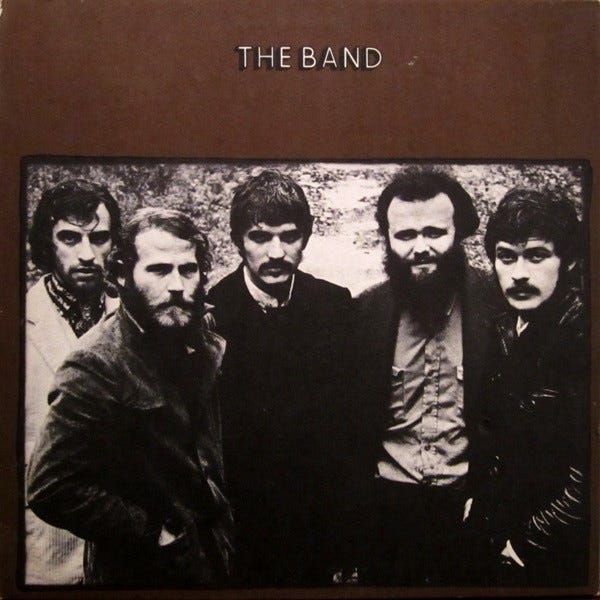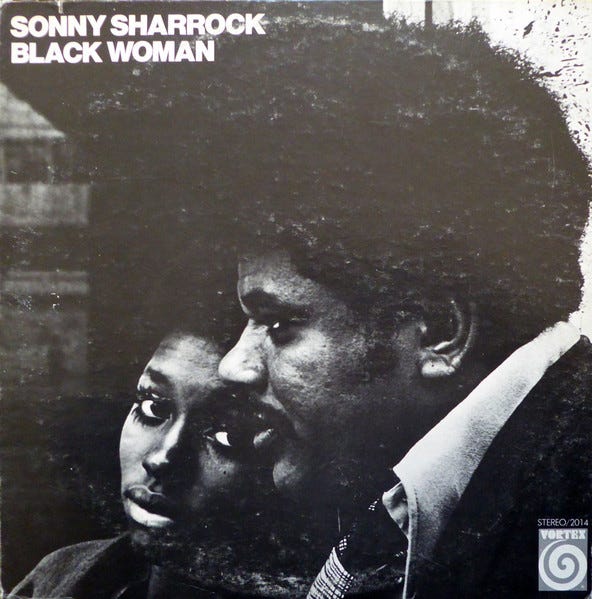Record Collecting: 1969 (6- and 12-string Guitar thru Black Woman)
Leo Kottke, The Beatles, The Kinks, The Band, and Sonny Sharrock
Welcome to my series on record collecting, where we select 30 albums to target for each year between 1960 and 2020. You can find the manifesto here, including links to other entries. In short, as I map my own thinking on how to invest in building a record collection, I hope it will be a useful guide in thinking about yours. The goal is a personal collection that doubles as a modern art musical library with, you know, killer tunes. Apologize in advance for the massive gaps in my musical knowledge. That’s what the comment section is for.
The year is 1969. Woodstock, Altamont, the Harlem Cultural Festival, The Beatles’ rooftop concert, Alice Cooper’s “Chicken Incident.” Miles Davis uses a wah-wah pedal. Johnny Cash performs at San Quentin. John Lennon and Yoko Ono marry and turn their honeymoon into a “Bed-In” for peace. The Winstons release the single “Color Him Father,” which features the “Amen break” on the B-side, one of the most widely used samples ever. Sundar Pop revolutionizes Indo-Caribbean music with the popularization of his chutney music style. Elvis returns to live performances in Las Vegas. Hee Haw and The Johnny Cash Show premiere, while the final episode of The Banana Splits Adventure Hour airs. Judy Garland overdoses; Brian Jones drowns; Skip James dies of cancer; Coleman Hawkins succumbs to liver disease. Diana Ross & The Supremes’ single "Someday We'll Be Together" is their last hit together as well as the Billboard Hot 100’s final top-charting single of the 1960s.
See all of the 1960s selections
See all selections listed by artist
1969
Part 1
Listed alphabetically by album title
Leo Kottke - 6- and 12-string Guitar (Takoma)
American primitivism
American primitivism’s best-seller. John Fahey develops the style, a vernacular American approach to the guitar, drawing from country-blues in Appalachia and the Mississippi Delta and expanding it with elements of the avant-garde, neo-classical, and raga. In other words, a single, often-acoustic guitar playing a whole mess of sound. Most of the players emerging in Fahey’s wake are endlessly impressive in their technique and imagination, but Kottke’s ability to play both aggressively and cleanly—so much so he eventually develops near-crippling tendinitis—captures an audience primed for more exploratory styles. He records the 14 tracks in order over a few hours, songs with titles as dense as the harmonics, shimmering waves of nylon acoustics, drama-filled and captivating. No wonder it sells so well, even for its complexities.
The armadillo album cover. Something in the dense intricacy of the animal’s scales matches the music… though that may be too cute by half. The black-and-white and olde-time-country-store styling also play well with the vibe evoked by American primitivism. Well done by the designer.
The Beatles - Abbey Road (Apple)
album rock
The final record. The Beatles, struggling to remain a cohesive unit, record it after the tense Let It Be sessions even though they end up releasing it before. They decide to make it “the way we used to,” with George Martin back fully in the production chair. And boy does he produce. It is an immaculate set of pop-rock, leveraging the studio (and George Harrison’s Moog) while restraining it from going completely Sgt. Pepper-wild. Side one is a bit more traditional in its collection of stand-alone tracks: John Lennon’s weirdo psych-funk “Come Together,” Harrison’s iconic “Something,” Paul McCartney’s backward-looking “Oh! Darling,” and Ringo Starr’s lovely country-pop tune “Octopus’s Garden.” McCartney mostly takes over side two though with a 15-minute medley that has its moments (“She Came in Through the Bathroom Window”) but is out-shined by Harrison’s warm-hearted opener, “Here Comes the Sun.” And though Abbey Road is a collection of pieces, it feels like a singular artistic statement thanks to Martin’s production. From homage-heavy Merseybeat to refined album rock, The Beatles finish their arc with appropriate magnitude.
The jacket is iconic. Doesn’t even need a title. (Well, you know, don’t tell anyone or anything, but the reason McCartney doesn’t have any shoes, it’s because he is actually dead, and his cigarette is on the wrong hand, and the funeral procession, and the license plate meaning…)
The Kinks - Arthur (Or the Decline and Fall of the British Empire) (Reprise)
art rock
The words just keep coming. Ray Davies is a lyricist first, so it makes total sense that he is recruited to develop the story and soundtrack for a televised play. A concept is developed—a carpet layer is down-and-out in post-war England and looks to Australia for new opportunities—and the music is written and recorded. But the actual play never happens. Instead, we get a concept record, a very familiar mode for The Kinks. Also very familiar for the band, it is critically-loved but sells poorly. Davies’s narrations are, as always, nostalgic, detailed, wordy, and often cutting (“Someone has killed some mother's son today”). The music keeps up, imaginative pop-rock with theater-kid flair, given extra energy by the horn accompaniment. They even stretch out into near-psychedelic territory on songs like “Australia.” There are no singles on the level of “Waterloo Sunset” here, but taken as a whole, Davies and gang are wildly successful delivering an ambitious narrative album that is as comfortable being close-read as it is enjoyed loudly.
It’s a cover that instantly dates you to late 60s/early 70s UK. It is that Monty Python style of cut-out chaos, not to mention the British symbolism among a bleak (Australian?) landscape. I just don’t like the band photo; feels out of place.
The Band - The Band (Capitol)
country-rock
A Southern rock masterpiece made by Canadians in the Hollywood Hills. Only Creedence can match the cognitive dissonance. Guitarist Robbie Robertson is the principal songwriter this time, but The Band’s egalitarian band-ness remains strong. The group-composition style is readily apparent in the music’s densely interwoven country-rock textures. Everyone has a part, nearly all of the time. The vibe is as sepia-toned as the album cover, dipping into folk traditions and finding empathy everywhere, even for a Confederate soldier processing his loss—an uncomfortable character study given a deeply sorrowful voice by Levon Helm. The music has a whiskey-wet boogie throughout, sometimes circling with an introspective grin and sometimes deeply swaying as the night gets away. It’s a portrait of the South made by and (in some ways) for non-Southerners. Think a piece of culturally penetrating literature written by an outsider; the individual provides a unique perspective while having enough distance to navigate the many blind spots of someone steeped in the tradition.
There is an argument that this cover photo sets the Southern rock style from here on out, especially your facial hair options. I love the simplicity of the title as well. A real accomplishment of design.
Sonny Sharrock - Black Woman (Vortex)
avant-garde soul-jazz
Emphasis on the avant-garde, emphasis on the soul, emphasis on the jazz. Despite Sonny Sharrock composing the five tracks here, the album really should be credited to Sonny & Linda Sharrock. Linda’s voice, wordless but endlessly compelling, a narrator of emotions, is as striking as Sonny’s razor sharp guitar. He communicates ideas in Cecil Taylor-like clusters of immediate expression; she communicates ideas in streams of building momentum. Drummer Milford Graves, pianist Dave Burrell, and double bassist Norris Jones admirably keep up, supporting without asking for the spotlight. The album often feels like an expression of stress: the multi-system response, the simultaneous de-personalization and hyper-arousal, the clenching in, the expelling of all that pent-up energy. That’s a lot for a single jazz record, but Sonny and Linda Sharrock don’t take artistic opportunities for granted. So they emphasize everything, and it somehow still leaves you wanting more.
Linda Sharrock has your eye on the album cover, and it is hard to let go. Yet another argument her name should be on the masthead.









